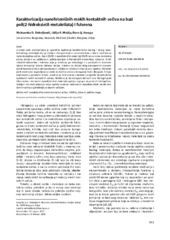Приказ основних података о документу
Karakterizacija nanofotoničnih mekih kontaktnih sočiva na bazipoli(2-hidroksietil-metakrilata) i fulerena
Characterization of nanophotonic soft contact lenses based on poly(2-hydroxyethyl methacrylate) and fullerene
| dc.creator | Debeljković, Aleksandra | |
| dc.creator | Matija, Lidija | |
| dc.creator | Koruga, Đuro | |
| dc.date.accessioned | 2022-09-19T17:11:55Z | |
| dc.date.available | 2022-09-19T17:11:55Z | |
| dc.date.issued | 2013 | |
| dc.identifier.issn | 0367-598X | |
| dc.identifier.uri | https://machinery.mas.bg.ac.rs/handle/123456789/1710 | |
| dc.description.abstract | U ovom radu predstavljeno je uporedno ispitivanje karakteristika baznog i novog nanofotoničnog materijala koji je dobijen inkorporiranjem nanomaterijala u bazni materijal za meka kontaktna sočiva. Bazni (SL38) i nanofotonični materijal (SL38-A) za meka kontaktna sočiva dobijeni su radikalnom polimerizacijom 2-hidroksietil-metakrilata, odnosno 2-hid-roksietil-metakrilata i fulerena koja je izvedena po tehnologiji i u proizvodnim laboratorijama kompanije Soleko (Milano, Italija). Fulereni su dodati zbog apsorpcionih transmi-sionih karakteristika u ultraljubičastom, vidljivom i bliskom infracrvenom spektru. Od dobijenih materijala napravljena su meka kontaktna sočiva u kompaniji Optix (Beograd, Srbija). Izračunati su parametri mreže, urađena je SEM analiza i merene su optičke karakteristike ispitivanih mekih kontaktnih sočiva. Utvrđeno je da transport tečnosti kroz hidrogel prati Fikov zakon i da bazni i nanofotonični materijal spadaju u grupu neporoznih hidrogelova. Dobijeni rezultati pokazuju bolja optička svojstva sintetisanih nanofotoničnih mekih kontaktnih sočiva u poređenju sa baznim sočivom. | sr |
| dc.description.abstract | This work presents a comparative study of characteristics of a basic and new nanophotonic material, the latter of which was obtained by incorporation of fully Rene, C60, in the base material for soft contact lenses. The basic (SL38) and nano-photonic materials (SL38-A) for soft contact lenses were obtained by radical polymerization of 2-hydroxyethyl methacrylate and 2-hydroxyethyl methacrylate and fullerene, which were derived by the technology in the production lab of the company Soleko (Milan, Italy). The materials were used for production of soft contact lenses in the company Optix (Belgrade, Serbia) for the purposes of this research. Fullerene was used due to its absorption transmission characteristics in ultravilet, visible and near infrared spectra. For the purposes of material characterization for potential application as soft contact lenses, network parameters were calculated and SEM analysis of the materials was performed, while the optical properties of the soft contact lenses were measured by a Rotlex device. The values of the diffusion exponent, n, close to 0.5 indicated Fick's kinetics corresponding to diffusion. The investigated hydrogels could be classified as nonporous hydrogels. Values of optical power and map of defects, determined using a Rotlex device, showed that the optical power of the synthesized nanophotonic soft contact lens was identical to the nominal value, while this was not the case for the basic lens. In addition, the quality of the nanophotonic soft contact lens was better than the basic soft contact lens. Hence, it is possible to synthesize new nanophotonic soft contact lenses of desired optical characteristics, implying possibilities for their application in this field. | en |
| dc.publisher | Savez hemijskih inženjera, Beograd | |
| dc.relation | info:eu-repo/grantAgreement/MESTD/Integrated and Interdisciplinary Research (IIR or III)/45009/RS// | |
| dc.rights | openAccess | |
| dc.rights.uri | https://creativecommons.org/licenses/by-nc-nd/4.0/ | |
| dc.source | Hemijska Industrija | |
| dc.subject | PHEMA | sr |
| dc.subject | optička snaga | sr |
| dc.subject | nanofotonična meka kontaktna sočiva | sr |
| dc.subject | fulereni | sr |
| dc.subject | PHEMA | en |
| dc.subject | optical power | en |
| dc.subject | nanophotonic soft contact lenses | en |
| dc.subject | fullerenes | en |
| dc.title | Karakterizacija nanofotoničnih mekih kontaktnih sočiva na bazipoli(2-hidroksietil-metakrilata) i fulerena | sr |
| dc.title | Characterization of nanophotonic soft contact lenses based on poly(2-hydroxyethyl methacrylate) and fullerene | en |
| dc.type | article | |
| dc.rights.license | BY-NC-ND | |
| dc.citation.epage | 870 | |
| dc.citation.issue | 6 | |
| dc.citation.other | 67(6): 861-870 | |
| dc.citation.rank | M23 | |
| dc.citation.spage | 861 | |
| dc.citation.volume | 67 | |
| dc.identifier.doi | 10.2298/HEMIND120830019D | |
| dc.identifier.fulltext | http://machinery.mas.bg.ac.rs/bitstream/id/560/1707.pdf | |
| dc.identifier.scopus | 2-s2.0-84891448538 | |
| dc.identifier.wos | 000329540700001 | |
| dc.type.version | publishedVersion |


